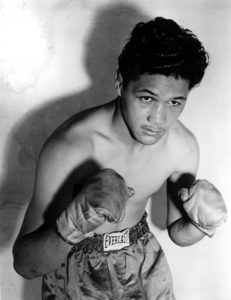Bernard Docusen
Bernard Docusen started boxing at the age of 12 and won the National Amateur Athletic Union bantamweight title in 1942 at the age of 14.

Courtesy of Boxrec Boxing Encyclopedia
Bernard Docusen. Unknown
In the segregated post–World War II South, professional boxer Bernard “Big Duke” Docusen often had to overcome legal challenges in order to compete in the ring, fighting racial allegations that he was black. He had been registered in several states as “colored,” but Louisiana law of the time barred blacks and whites from competing against each other in athletic contests. On March 29, 1949, New Orleans Civil District Judge Rene Viosca ruled that Docusen and his brothers Reggie and Maxie, known regionally as the “Battling Docusen Brothers of Louisiana,” were “half-White” and not “colored.” By this time Docusen had been a prizefighter for four years and had compiled a record of sixty-seven wins in sixty-eight bouts.
Docusen was born in New Orleans on January 19, 1927, the second of six sons born to Regino Elegado Docusen, a native of the Philippines who had served in the US Army as a member of the Old Philippine Scouts, and a French mother, Viola DelMolle Lytell. He started boxing at the age of twelve, and at fourteen won the National Amateur Athletic Union (AAU) bantamweight title in 1942 against Eddie Dames. He left high school after his sophomore year to work with his father on his shrimp trawler, but Bernard Docusen continued to box whenever the opportunity presented itself.
Docusen married Ernestine Tules when he was just seventeen years old, but by then he was already a professional boxer. Docusen’s first professional bout was a first-round knockout against George Marino on February 8, 1948, at the Victory Arena in New Orleans. Eventually Docusen came under the guidance of famed trainer Whitey Esneault, who molded the young pugilist into a ranked contender in his cramped riverfront gymnasium. Esneault also trained Docusen’s brothers.
Docusen fought in many of the largest boxing venues in the country—Madison Square Garden in New York City; Ebbets Field in Brooklyn, New York; Comiskey Park in Chicago, Illinois; and the Olympic Auditorium in Los Angeles, California. His most notable fight came on June 28, 1948, at Comiskey Park against the legendary Sugar Ray Robinson for the world welterweight championship. Docusen came into the match as the number three–ranked contender and fought evenly and competitively against Robinson until the eleventh round, when the champion floored the challenger for a nine-count. For the remainder of the fight Robinson had the upper hand.
His final fight was a seventh-round technical knockout loss to Joey Giambra in Buffalo, New York, on February 24, 1953, due to a severe cut on Docusen’s upper lip. He retired with a record of seventy-four wins, ten losses, and six draws. He was elected to the New Orleans Sports Hall of Fame in 1976, the California Boxing Hall of Fame in 2008, and the World Boxing Hall of Fame in 2010.
Docusen settled in the Detroit area and worked as a welder and as a custodian at a local high school for several years. He died on January 11, 2009, at the age of eighty-one. Boxing writer Bob Ryder described him in his obituary as “one of boxing’s uncrowned champions of the 1940s-1950s.”
